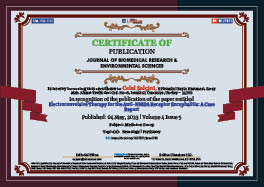Celal Salcini*, Ahmet Yosmaoglu, Nevzat Tarhan and Oguz Tanridag
Volume4-Issue5
Dates: Received: 2023-04-29 | Accepted: 2023-05-02 | Published: 2023-05-04
Pages: 853-855
Abstract
Anti-NMDA encephalitis is a rare autoimmune disorder that affects the central nervous system. We report a case of a 22-year-old male patient with a history of prodromal flu-like symptoms followed by brief aggression episodes, paranoid symptoms, and stereotypic movements. Routine blood work, a brain MRI, and an EEG were normal. Cerebrospinal Fluid (CSF) studies show no abnormality, and the neuronal antibody panel was administered. Antipsychotics and benzodiazepines did not have any benefits, and Electroconvulsive Treatment (ECT) was recommended for the ongoing symptoms of catatonia. Movement disorders and cognition gradually improved after the second session of ECT. Later, CSF study results demonstrated the presence of anti-NMDA antibodies, and standard therapy was administered. Our case suggests that ECT may be an effective treatment option for patients with anti-NMDA encephalitis. Further studies are needed to confirm the efficacy and safety of ECT in this patient population.
FullText HTML
FullText PDF
DOI: 10.37871/jbres1743
Certificate of Publication

Copyright
© 2023 Salcini C, et al. Distributed under Creative Commons CC-BY 4.0
How to cite this article
Salcini C, Yosmaoglu A, Tarhan N, Tanridag O. Electroconvulsive Therapy for the Anti-NMDA Receptor Encephalitis: A Case Report. J Biomed Res Environ Sci. 2023 May 04; 4(5): 853-855. doi: 10.37871/jbres1743, Article ID: JBRES1743, Available at: https://www.jelsciences.com/articles/jbres1743.pdf
Subject area(s)
References
- Coffey MJ, Cooper JJ. Electroconvulsive Therapy in Anti-N-Methyl-D-Aspartate Receptor Encephalitis: A Case Report and Review of the Literature. J ECT. 2016;32(4):225-9. Epub 2016/06/14. doi: 10.1097/YCT.0000000000000334. PubMed PMID: 27295461.
- Warren N, Grote V, O'Gorman C, Siskind D. Electroconvulsive therapy for anti-N-methyl-d-aspartate (NMDA) receptor encephalitis: A systematic review of cases. Brain Stimul. 2019;12(2):329-34. Epub 2018/12/12. doi: 10.1016/j.brs.2018.11.016. PubMed PMID: 30528383.
- Lehtimaki K, Keranen T, Huuhka M, Palmio J, Hurme M, Leinonen E, et al. Increase in plasma proinflammatory cytokines after electroconvulsive therapy in patients with depressive disorder. J ECT. 2008;24(1):88-91. Epub 2008/04/02. doi: 10.1097/YCT.0b013e3181571abb. PubMed PMID: 18379341.
- Pirnia T, Joshi SH, Leaver AM, Vasavada M, Njau S, Woods RP, et al. Electroconvulsive therapy and structural neuroplasticity in neocortical, limbic and paralimbic cortex. Transl Psychiatry. 2016;6(6):e832. Epub 2016/06/09. doi: 10.1038/tp.2016.102. PubMed PMID: 27271858; PubMed Central PMCID: PMCPMC4931600.






























































